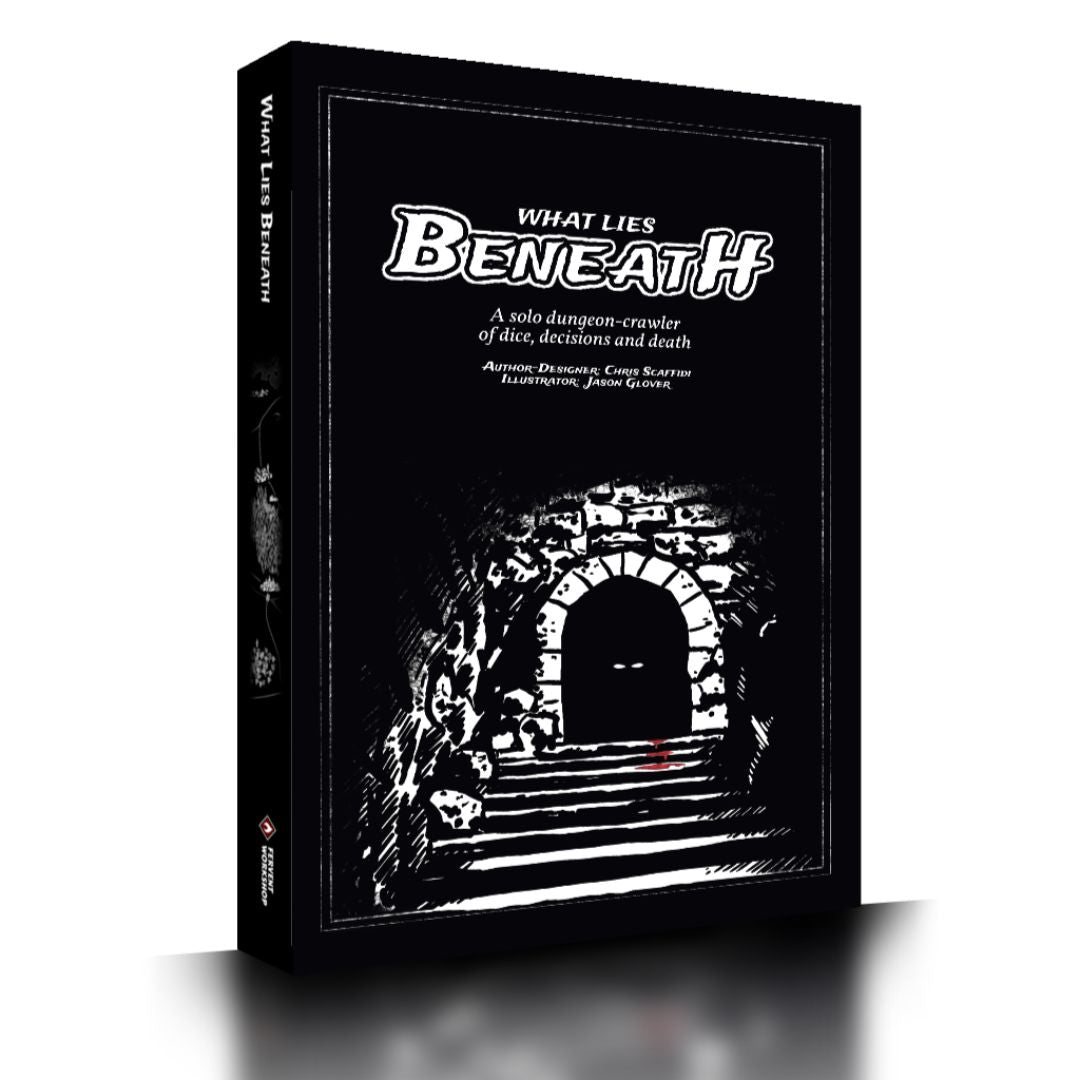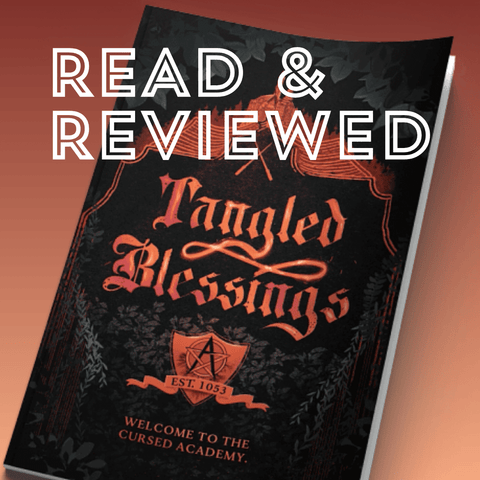By Christopher John Eggett
This review contains very light spoilers for content, and some large spoilers for mechanics – if you’ve already got this game in your basket, just buy it, play it and return to read this after. The surprises that turn up are worth the price of admission alone. Also, What Lies Beneath repeatedly uses the term ‘tumor’ to describe a mysterious affliction, which may be difficult for some readers.
What Lies Beneath might be ‘the real Dark Souls’ of Choose Your Own Adventure games.

And I don’t mean that because it’s sometimes hard and you can die a lot. I say it because of the thing that people actually really like about Dark Souls: the way the player inevitably builds up a familiarity with a wretched place, how they chisel out a route through a world, and how they get to test what can be achieved within the confines of the game.
Yes, it’s a gritty fantasy world with all of the expected nasty fun of a Fighting Fantasy book, and there’s cryptically described items, and you start not really knowing who you are… but there’s so much more in the long dark halls and paranoia-inducing woods of What Lies Beneath than you could possibly expect.
There are certain elements of a FromSoft game which aren’t so much to do with how good you are at swinging swords and understanding the application of weird objects, but instead act as a ‘knowledge check’ against the world itself. That’s what we’re replicating here in What Lies Beneath.
Your interaction with the world is one of learning things for the first time, sometimes at the sharp end of a sword, and then having another go (because of the sword you just died on). But this time you can make better choices. Baking that into a Choose Your Own Adventure format is one of the great triumphs of What Lies Beneath.
Because the world doesn’t change, but your actions within it do, the game offers you some meta-layer that recognises you as a player. When you die, you’re not ripped out of a world suddenly, you’re reset and ready.

What Lies Beneath isn’t about a role you’re taking on to drive through a movie. Compared to, for example, the excellent Graphic Novel Adventures published by Van Ryder games, this is much more of a game of making the right choices, rather than exploring story threads. Much more about ‘place’ and revealing your purpose than racing to the page that says ‘you win’.
This is because of a clever little checkpoint system that allows you to spend your accrued XP on the next character, and start them out from an end-of-act-one ‘save point’. What Lies Beneath is full of surprises like this. Even the core set of stat tests involve more than a ‘roll the right number’, instead asking you to perform feats of real-life dexterity.
I really expected this to be a classic, gritty, dungeon crawl with instant-death trap rooms and fighting the urge to leave your finger on the last page to do a ‘actually, it didn’t happen like that’ with some basic stat-based dice rolling to get us through.
But it’s so much more. There’s a meaningful difference to how your ‘build’ is going when it comes to challenges and tests. Each different stat (Hit, Dex, Wit) requires a different kind of test. Hit is a simple ‘get over target number’ deal, with a dice pool rolled based on your Hit stat. Wit is a puzzle of rolling dice and then manipulating them into a run – making as many changes as you have Wit stat points.

Dex was the curveball. Stack two dice, flick a third dice from the numbered distance (there’s a ruler on the character sheet, a genius bit of design) and try to touch the stack with the flicked dice without knocking them over.
This isn’t the only dice trick that made me think “I’ve not played enough 3-hour-long D&D combats to be this good at messing around with dice”. Spinning a dice on its edge and counting the seconds to get a result was a real challenge for me to get a ‘good’ score on.
My advice is to do a little warm up on the exercises before kicking off an adventure or trying the test ‘for real’. These dexterity challenges were both the most frustrating (because I am rubbish at them, or at least, worse at them than being lucky) but also the most satisfying when I improved my hit rate somewhat. Once you have the knack, it’s a lot more straightforward – probably a bit like your average dexterity test in real life.
(Importantly, there are alternative rules for Dex tests in the back of the book, which is a good accommodation to players who either find it too frustrating or aren’t able to complete the test.)
There’s something really addictive about these little games. I’m particularly fond of the dice manipulation found in the Wit tests. It might be that I played too much Dice Hospital or Sagrada, but there’s something really pleasing about the simple ‘get a run of numbers in a row with certain manipulations’.
And the one-off tests built into encounters that don’t necessarily use your stats are also inspired. Really there’s dozens of mechanical treats within What Lies Beneath, and each does feel like a little dessert that’s been put down in front of you, gratis. These are the rewards for exploring each angle, face and strand of the story.

As we’ve arrived at the story I need to say I’m going to try and avoid giving too much away, providing too many spoilers – though I do wish I could tell you about my favourite death in the game. It had me laughing enough for my partner to enquire what was so funny. Death, like many jokes, isn’t as funny when you have to explain it, it turns out.
But this is the wit and skill of Chris Scaffidi’s writing and design. We’re playing with tropes, with what we know about “games like this” and then subverting them. Some passages are provided with a wink from the author – it feels like anyway – and that’s totally fine because the game mechanically supports the fact that you’re there reading the book, that there is a player and not just someone turning the wheel that makes the story go whoosh.
It’s an almost personal engagement between designer and player, in the way a GM has a personal engagement with their group. We agree that we’re working in a world of fantasy make-believe and yes, Sharon, you are half-dragon lady with a ukulele and I don’t know why you’re bringing it up, but also you’re Sharon who still wants help with the car boot sale next weekend. And it’s the same here, you and Chris Scaffidi are running with the same knowledge – albeit from the magical asynchronous information technology we know of as ‘a book’.
Your story starts, as many great games do, in a dungeon having forgotten your name, who you are and, importantly, where you are. And the answer to that last query is more or less: somewhere completely awful. A crypt in fact. You’ve contracted something horrible in this dungeon (see content warning) and you’re going to have to find a way out of here without losing your head.
The writing is a grody kind of grimdark. Mucky, bodily, occasionally gross. It’s written with a flourish of blood and body that can often come out of nowhere – which could be called immersion, but might just be the literary equivalent of a jumpscare. It’s got a magician’s flourish to it throughout in a way that only gets more pleasing as you begin to pile up your own corpses. Your first run through this horrible little pit will see you try your best to survive. But after your inevitable death you’ll start to strategise in a way outside of the confines of the page in front of you.

And this is a large game. Its scope blossoms out in the second act onwards. So while any choices you make might seem like the right one narratively in the moment, you are shutting doors on this great expanse. This giant web of options is both highly varied but makes sense within the confines of the story itself – you may even be scandalised by what you didn’t know on your last playthrough.
This feeling of pushing up against all sides of the story as you expand what you know about your character and the world you’re in is one of the ways the game draws you back in for another go. The fact that my first playthrough ended with a description I was perfectly happy to call a ‘Victory’ but was in fact termed a ‘Survival’ showed me that I wasn’t even scratching the surface. And it’s true, that first playthrough (or rather, the first one that didn’t end in death) was about survival, and not about discovering the full potential of the character.
The sheer variety of endings, each satisfying in their own way, is impressive. Each is its own pocket reality of the choices you made to get there, a reflection of the kind of game you played (in addition to how well you rolled, flicked and manipulated). While we can’t go as far to say that this is a ‘living world’ we are treated to an extended panorama. The living world is the one you piece together in your head from multiple playthroughs, as you simply won’t know the full truth until you’ve lived several lives here.
It’s not as complex as daydreaming about the different character ‘builds’ as you might do in Elden Ring, but there is a little bit of that about it. There’s this thought that: ‘yes, next time, I’ll choose a different class and that will open up different options which will make certain items more useful now I know roughly where to find them’. The item and tag system uses a short string of letters like, say, EGG, to allow you to make choices between EGG and, for example, CHKN. You’ll look these up in the back of the book and discover their weirdly specific qualities and uses. Even if it doesn’t solve the problem of which comes first.

Each item tells you a little more about the kind of fantasy world you’re in, in the same way the monsters and enemies do. Are we in a world of grotty low fantasy, or is just your current situation really grotty? I honestly can’t share anything without spoiling many of the excellent encounters. It’s not that it’s a perfectly made world, but that each element – even if it doesn’t perfectly tessellate with others elements – adds so much flavour that all is forgiven.
And What Lies Beneath has a great rhythm to it. A tight and claustrophobic opening leading to wide expanses and massive forks in the road for the second act. Choices around survival and picking your new goal can heighten tension again for the middle period, where you can really unpick the root of the story. And then there’s usually a tricky finesse to be had toward the closing acts for the most satisfying payoffs. If these were the beats of a film or a novel, you’d be more than satisfied that it moves, is generous, and gives you the kind of good surprises that keep you glued to the page.
What Lies Beneath is a masterfully delivered story that just happens to require you to play it multiple times to uncover the truth. It’s smart, knowing, and often quite funny despite its dark themes. Take some time to tour the dungeons, explore the woods and [spoiler] your [spoiler] with the [spoiler]! And you won’t regret it.

Spoiler for my favourite Death, revealing only the encounter number: E71.
Christopher John Eggett is a writer, editor and game designer from the UK. He was previously the editor of the monthly print magazine Tabletop Gaming. Chris and his partner make small solo and tabletop roleplaying games as Ada Press (https://adapress.itch.io/). Find him on BlueSky at @cjeggett.co.uk (https://bsky.app/profile/
© 2025 Tabletop Bookshelf





Comments (0)
There are no comments for this article. Be the first one to leave a message!